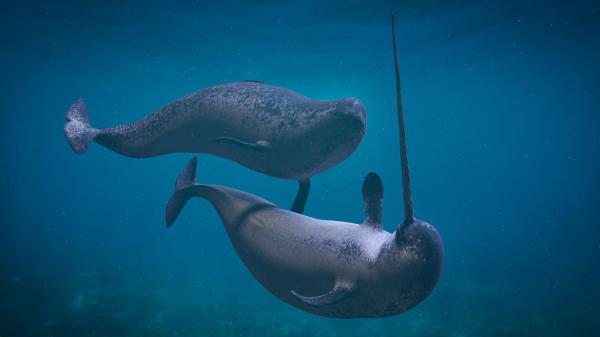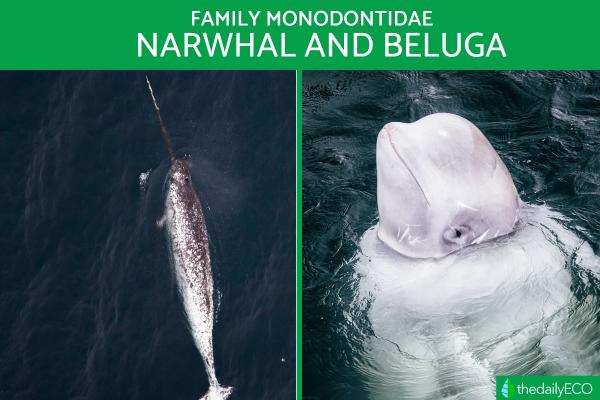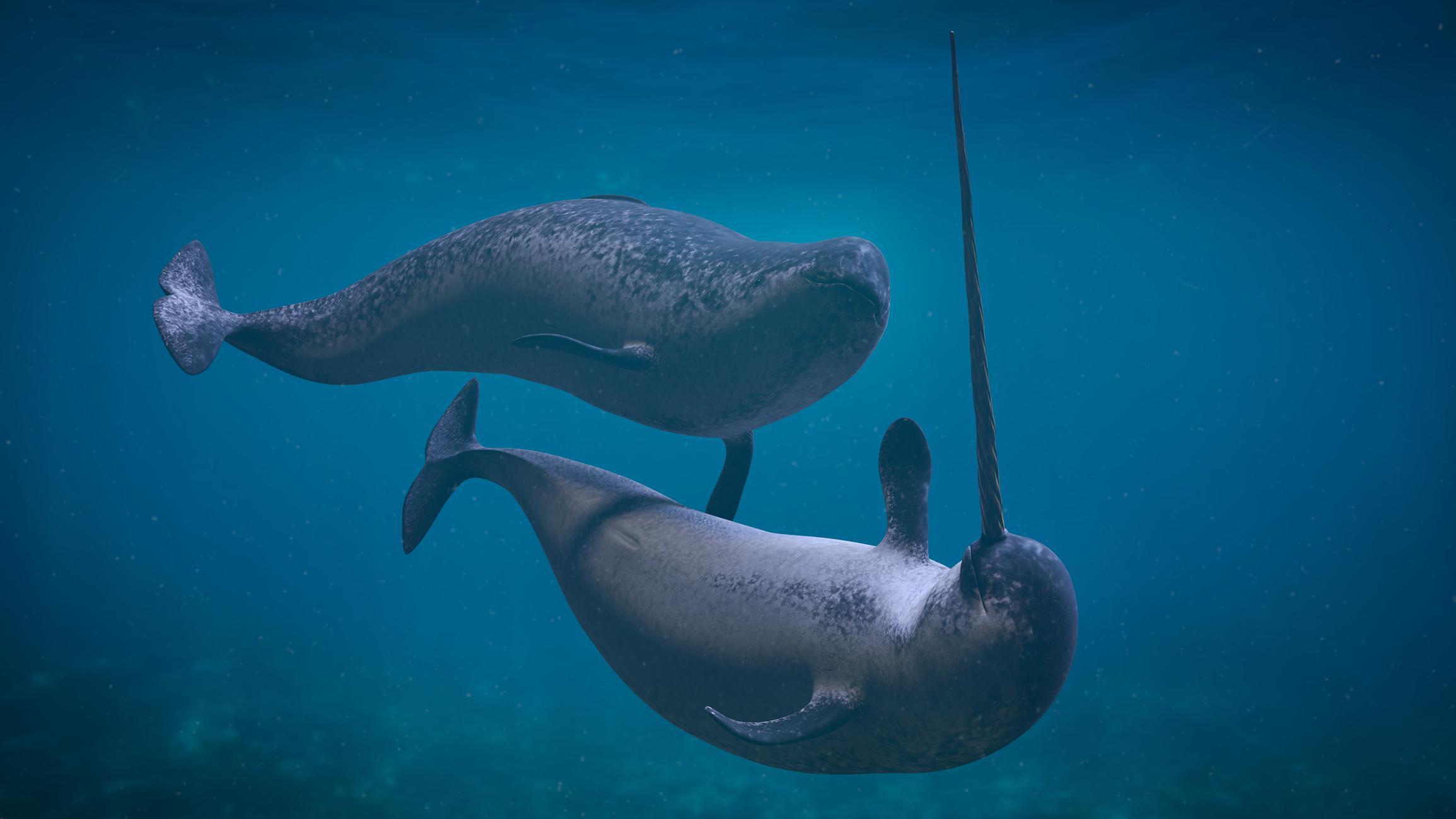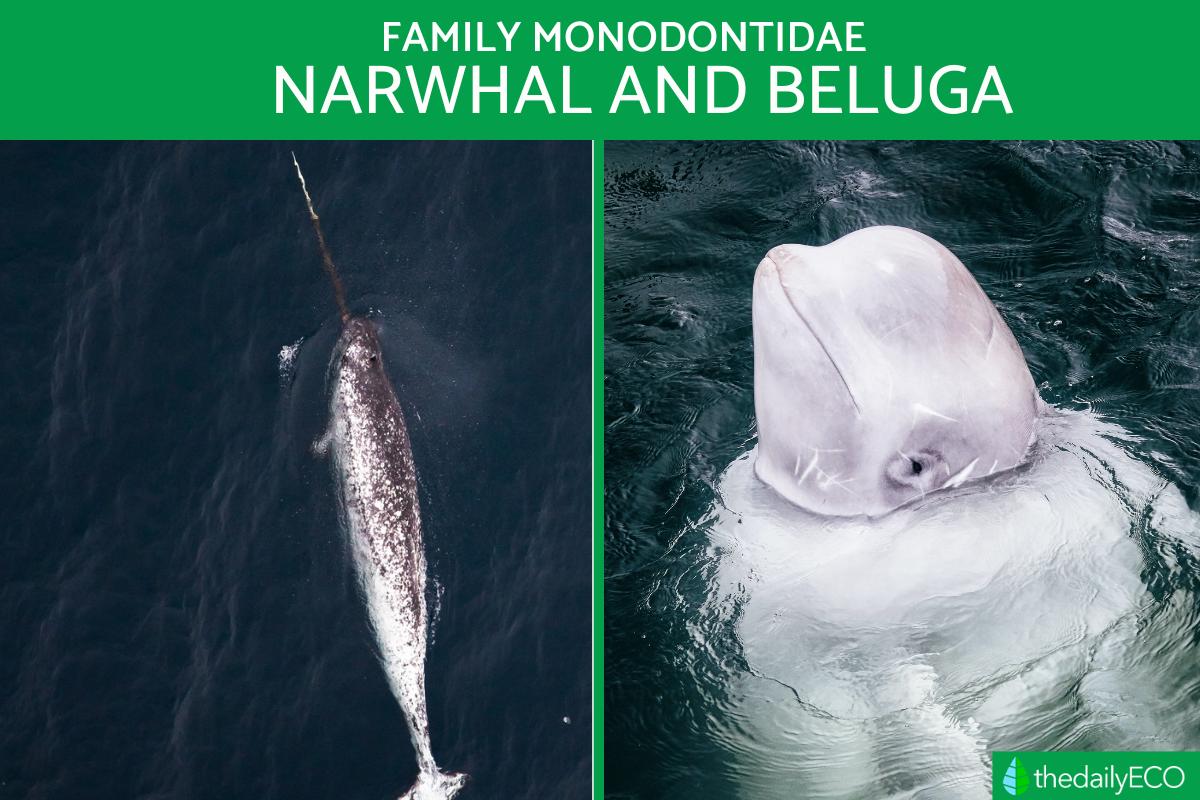Monodontids - Beluga and Narwhal


The Monodontidae, also known as the family of narwhals and belugas, is a group of Arctic and subarctic cetaceans known for their distinctive physical and behavioral characteristics. These marine mammals are known for their unique characteristics, such as their tusk (in the case of narwhals), their white skin (in the case of belugas), and their high volume. The Monodontidae are a small family, but these species play an important role in the ecosystem of their Arctic and subarctic habitats.
In this article from thedailyECO, we explain what Monodontidae are and examine their physical and behavioral characteristics, as well as their unique adaptations to life in the harsh, cold waters of the Arctic and subarctic regions.
What are monodontids?
Monodontidae, also known as monodontids is a family of cetaceans that belongs to the order Cetacea, which also includes dolphins, porpoises, and whales.
Within the order Cetacea, Monodontidae is part of the suborder Odontoceti, which is characterized by having teeth and being predators.
Monodontidae is a family of marine mammals that only includes two species, the narwhal (Monodon monoceros) and the beluga whale (Delphinapterus leucas). Both species are toothed whales and are found in Arctic and sub-Arctic waters. While these two species are quite distinct from each other in terms of physical characteristics and behavior, they are classified together in the same family based on their genetic and evolutionary history.
They are highly adapted to their cold-water environments and have several unique physical and behavioral characteristics that distinguish them from other cetaceans. The Monodontidae play an important role in their ecosystems and are a fascinating subject of study for marine biologists and conservationists.

General characteristics of monodontids
The Monodontidae is a distinct family of toothed whales, consisting of only two species, which possess several unique characteristics that distinguish them from other cetaceans. The following are some of the notable features that are shared by Monodontids:
- They are highly vocal and use a complex system of clicks, whistles, and other sounds to communicate with each other. Belugas are known to be particularly vocal, with some individuals capable of producing up to 11 different types of vocalizations.
- They have a large forehead on which there is an organ called a melon, which is made of fatty tissue. This organ is used for echolocation.
- They are social and form groups, or pods, that can range in size from a few individuals to hundreds of animals.
- They are carnivores and feed primarily on fish, squid, and other marine invertebrates. Narwhals have been observed using their tusks to stun fish before consuming them.
- They are endothermic, meaning they regulate their own body temperature and have a thick layer of fat for insulation in their cold Arctic habitat.
- They do not have a dorsal fin, a feature common to dolphins and other cetaceans.
In the following sections, we will delve deeper into each of the Monodontidae species to examine their specific characteristics and traits.
For further reading, we recommend our article on sea ice definition, formation, and examples.
Beluga whale
The beluga whale, also known as the white whale, is a medium-sized cetacean that can grow up to 5.5 meters in length and weigh up to 1,600 kg. They are known for their distinctive white color and rounded forehead, which houses an organ called the melon that is used for echolocation.
Beluga whales are social animals that live in groups of up to several hundred individuals, known as pods. They are known for their vocalizations and can produce a wide range of sounds, including whistles, clicks, and squawks. Beluga whales are also known for their acrobatic behaviors, such as breaching and spyhopping.
Despite being one of the most widespread cetacean species, beluga whales face a number of threats, including hunting, habitat loss, and pollution. They are classified as Near Threatened by the International Union for Conservation of Nature (IUCN).
Narwhal
The narwhal is a medium-sized toothed whale that can reach lengths of up to 5 meters (16 feet) and weigh up to 1,600 kg (3,500 pounds).
They are known for their long, spiral tusk, which is actually a specialized tooth that can grow up to 3 meters in length in males. It has sensory capabilities that allow them to detect changes in water pressure and temperature. Narwhals are also known for their mottled gray and white coloration.
They feed on a variety of fish, squid, and shrimp and dive to depths of 1,500 meters in search of food. Due to their remoteness and the harsh conditions of their habitat, they are considered one of the most difficult animals to study.
Narwhals are an important subsistence resource for Inuit communities in the Arctic, but they also face a number of threats, including climate change, hunting, and entanglement in fishing gear. They are classified as Near Threatened by the IUCN.
How have the monodontids adapted to live in cold water?
Monodontidae have adapted and evolved to live in cold water in several ways:
- Thick layer of blubber: Monodontids have a thick layer of blubber under their skin, which serves as insulation against the cold. This blubber layer also stores energy that can be used during periods of food scarcity.
- Hydrodynamic shape: Their bodies have a hydrodynamic shape that helps them move through the water more efficiently. This shape also reduces drag, allowing them to swim faster and conserve energy.
- Large forehead with a melon: The large forehead of Monodontidae houses a unique organ called the melon, which is used for echolocation. This organ helps them locate prey and navigate in the murky waters of the Arctic.
- Adapted respiratory system: Monodontids have adapted respiratory systems that allow them to hold their breath for long periods of time. They also have a specialized structure called a spiracle, which helps them take in air without having to fully surface.
- Specialized teeth: The narwhal has a long, spiral tusk that is actually a modified tooth. This tusk helps the narwhal locate food and navigate through the ice. Beluga whales have cone-shaped teeth that are used to crush hard-shelled prey.
Monodontidae have evolved a suite of adaptations that allow them to survive in the harsh, cold environments of the Arctic. However, these adaptations also make them vulnerable to changes in their environment, such as warming waters and loss of sea ice. As such, conservation efforts are important to ensure the survival of these unique and fascinating marine mammals.
If you found this article interesting, you might also want to check out our article on icebergs.
If you want to read similar articles to Monodontids - Beluga and Narwhal, we recommend you visit our Biology category.
Beatty, R., Beer, A., & Deeming, C. (2010). The book of nature. Great Britain: Dorling Kindersley.






